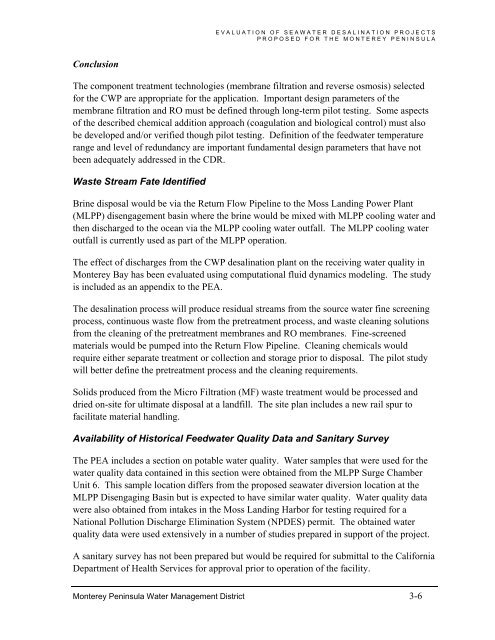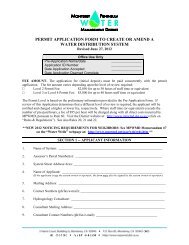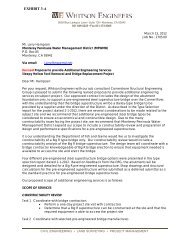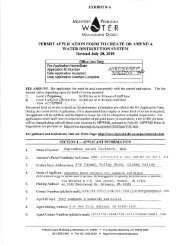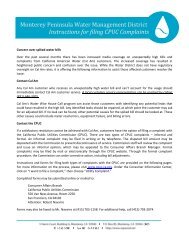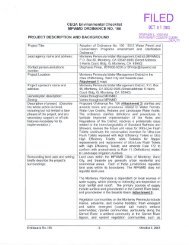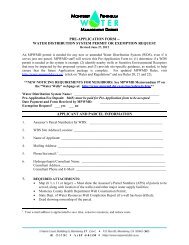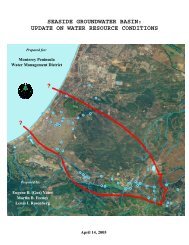FINAL REPORT Evaluation of Seawater Desalination Projects ...
FINAL REPORT Evaluation of Seawater Desalination Projects ...
FINAL REPORT Evaluation of Seawater Desalination Projects ...
Create successful ePaper yourself
Turn your PDF publications into a flip-book with our unique Google optimized e-Paper software.
EVALUATION OF SEAWATER DESALINATION PROJECTS<br />
PROPOSED FOR THE MONTEREY PENINSULA<br />
Conclusion<br />
The component treatment technologies (membrane filtration and reverse osmosis) selected<br />
for the CWP are appropriate for the application. Important design parameters <strong>of</strong> the<br />
membrane filtration and RO must be defined through long-term pilot testing. Some aspects<br />
<strong>of</strong> the described chemical addition approach (coagulation and biological control) must also<br />
be developed and/or verified though pilot testing. Definition <strong>of</strong> the feedwater temperature<br />
range and level <strong>of</strong> redundancy are important fundamental design parameters that have not<br />
been adequately addressed in the CDR.<br />
Waste Stream Fate Identified<br />
Brine disposal would be via the Return Flow Pipeline to the Moss Landing Power Plant<br />
(MLPP) disengagement basin where the brine would be mixed with MLPP cooling water and<br />
then discharged to the ocean via the MLPP cooling water outfall. The MLPP cooling water<br />
outfall is currently used as part <strong>of</strong> the MLPP operation.<br />
The effect <strong>of</strong> discharges from the CWP desalination plant on the receiving water quality in<br />
Monterey Bay has been evaluated using computational fluid dynamics modeling. The study<br />
is included as an appendix to the PEA.<br />
The desalination process will produce residual streams from the source water fine screening<br />
process, continuous waste flow from the pretreatment process, and waste cleaning solutions<br />
from the cleaning <strong>of</strong> the pretreatment membranes and RO membranes. Fine-screened<br />
materials would be pumped into the Return Flow Pipeline. Cleaning chemicals would<br />
require either separate treatment or collection and storage prior to disposal. The pilot study<br />
will better define the pretreatment process and the cleaning requirements.<br />
Solids produced from the Micro Filtration (MF) waste treatment would be processed and<br />
dried on-site for ultimate disposal at a landfill. The site plan includes a new rail spur to<br />
facilitate material handling.<br />
Availability <strong>of</strong> Historical Feedwater Quality Data and Sanitary Survey<br />
The PEA includes a section on potable water quality. Water samples that were used for the<br />
water quality data contained in this section were obtained from the MLPP Surge Chamber<br />
Unit 6. This sample location differs from the proposed seawater diversion location at the<br />
MLPP Disengaging Basin but is expected to have similar water quality. Water quality data<br />
were also obtained from intakes in the Moss Landing Harbor for testing required for a<br />
National Pollution Discharge Elimination System (NPDES) permit. The obtained water<br />
quality data were used extensively in a number <strong>of</strong> studies prepared in support <strong>of</strong> the project.<br />
A sanitary survey has not been prepared but would be required for submittal to the California<br />
Department <strong>of</strong> Health Services for approval prior to operation <strong>of</strong> the facility.<br />
Monterey Peninsula Water Management District 3-6


